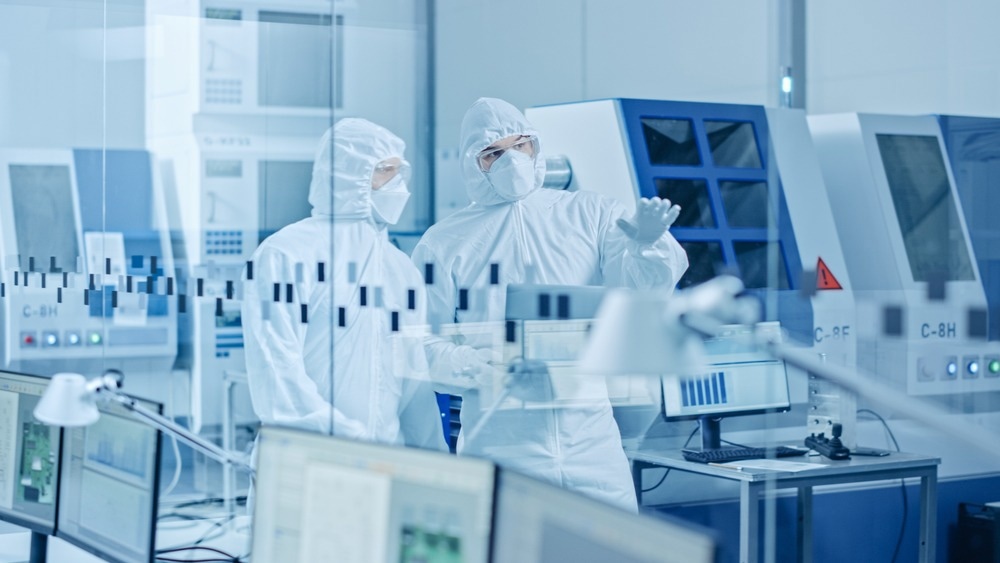The need for innovation in drug-making
Introduction to PAT in pharmaceutical manufacturing
Real-time monitoring and control
Reducing variability and waste
References
Further reading
Technological innovations throughout the past several decades have transformed the pharmaceutical manufacturing process from traditional batch production to autonomous and continuous manufacturing.

Image Credit: Gorodenkoff/Shutterstock.com
The rise of pharmaceutical continuous manufacturing (PCM), which is often supported by process analytical technology (PAT), has improved the safety, quality, efficacy, consistency, and purity of drugs.
The need for innovation in drug-making
The successful production of an active pharmaceutical ingredient (API), which is the chemical substance within a drug that is primarily responsible for its desired pharmacological activity, is often a complex process involving various chemical reactions. To ensure that the API is safe and effective, samples are frequently and sporadically collected throughout the manufacturing process for analysis.
These samples can be analyzed through various methods, some of which include titrimetric and chromatographic techniques, as well as nuclear magnetic resonance (NMR) spectroscopy and mass spectrometry (MS). Despite the high level of precision and selectivity associated with these techniques, they must be performed at a different time than when the sample was originally collected, thus limiting researchers from obtaining relevant information that is reflective of the continuous API manufacturing process.
Introduction to PAT in pharmaceutical manufacturing
"PAT is a system that allows for the design, analysis, and control of manufacturing through real time quality control and performance attribute measurements.”
According to the United States Food and Drug Administration (FDA), PAT can be further classified as multivariate tools, process analyzers, process control tools, as well as continuous improvement and knowledge management tools.
Taken together, these tools allow scientists to continuously and immediately obtain data on crucial API properties without the need for offline analysis, thereby improving the efficiency of drug manufacturing, as well as the selectivity, purity, efficacy, and output of APIs.
Spectroscopic techniques such as infrared (IR), Raman, and UV-Vis spectroscopy, chromatographic techniques, as well as particle size and mass measurement tools, can be incorporated in situ or through continuous flow systems to be considered PAT. For example, combining Raman and IR spectroscopy with advanced data analysis strategies such as machine learning and chemometric tools allows for extracting crucial information embedded within the data.
Comparatively, chromatographic techniques such as gas and liquid chromatography, which are the most common methods for PAT, separates samples into their gas and liquid mobile phases, respectively. When combined with other separation analytical techniques, these tools provide relevant information for evaluating pharmaceutical drugs to improve the manufacturing process ultimately.
Real-time monitoring and control
Traditionally, statistical process control (SPC) has been used throughout the pharmaceutical industry to ensure quality control. SPC involves a wide range of statistical methods, such as control and run charts, to inspect the quality and activity of intermediate and final pharmaceutical products.
Importantly, this quality control approach is limited in its ability to fully assess the quality characteristics of intermediate products during the actual manufacturing process. Furthermore, any problems that may arise during the production process require a greater amount of resources and time to resolve, thereby limiting the efficiency of these approaches.
To overcome these challenges, several alternative strategies have been introduced to ensure process control and validation. Continuous process verification (CPV), which was originally introduced by the International Council for Harmonization (ICH), requires the continuous monitoring and evaluation of pharmaceutical manufacturing processes.
As a result, CPV provides immediate information on any product variabilities with greater statistical confidence, thereby improving confidence in products produced through continuous manufacturing.
Quality by design (QbD) is another strategy that has been developed to mitigate the challenges associated with traditional statistical quality control in the pharmaceutical industry.
QbD principles
QbD is a systematic approach to development that begins with predefined objectives and emphasizes product and process understanding and process control, based on sound science and quality risk management.”
QbD tools include scientific risk-based systematic methods such as design of experiments (DoE), empirical modeling, and response surface analysis. QbD tools provide crucial information on product performance, identify critical process parameters (CPPs) during quality risk assessment during the product manufacturing process, and determine appropriate control strategies to control variables that may impact product quality.
Reducing variability and waste
By optimizing and improving the efficiency of pharmaceutical manufacturing processes, PAT directly reduces energy consumption, waste generation, and substandard material production. More specifically, by identifying potential errors in drug characteristics immediately and early in the drug manufacturing process, scientists can quickly intervene before large batches of unusable drugs are produced. Likewise, this type of in-line analysis eliminates sample packaging, transport, storage, and preservation activities, all of which are associated with excessive waste production and energy usage.
Compared to batch processing, PAT allows pharmaceutical manufacturing to be a continuous flow process with significantly less energy requirements. In-line measurements during continuous flow processes also reduce the need for re-calibrating instruments, thereby further reducing reagent and energy requirements.
References
- Ralbovsky, N. M., & Smith, J. P. (2023). Process analytical technology and its recent applications for asymmetric synthesis. Talanta 252. doi:10.1016/j.talanta,2022.123787.
Liu, P., Jin, H., Chen, Y., et al. (2023). Process analytical technologies and self-optimization algorithms in automated pharmaceutical continuous manufacturing. Chinese Chemical Letters. doi:10.1016/j.cclet.2023.108877.
- Aramouni, N. A. K., Steiner-Browne, M., & Mouras, R. (2023). Application of process analytical technology (PAT) in real-time monitoring of pharmaceutical cleaning process: Unveiling the cleaning mechanisms governing the cleaning-in-place (CIP). Process Safety and Environmental Protection 177; 212-222. doi:10.1016/psep.2023.07.010.
- Kim, E. J., Kim, J. H., Kim, M., et al. (2021). Process Analytical Technology Tools for Monitoring Pharmaceutical Unit Operations: A Control Strategy for Continuous Process Verification. Pharmaceutics 13(6). doi:10.3390/pharmaceutics13060919.
Further Reading
Last Updated: Oct 16, 2023